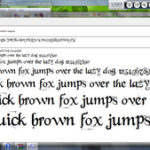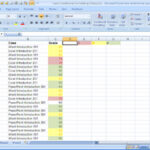Creating paragraph styles in InDesign can simplify the task of formatting your text any time you lay out an InDesign project. By creating a variety of paragraph styles, not only can you save yourself a lot of precious time when it comes to adjusting font size and leading, but you can also give yourself a variety of different style options with just a single click.
In this tutorial, I’ll show you how to access your paragraph styles and how to create your own styles that can be applied to any type you create within InDesign. To begin, you’ll need to locate your paragraph styles menu. In InDesign CS2 the paragraph styles menu is located on a tab in the box containing object styles, character styles, and swatches and is located on the far right hand side of your InDesign workspace.
When you first open your paragraph styles menu you’ll see a listing for a Basic Paragraph, which is the default style which InDesign will apply to all of the type you put into your document. The basic paragraph style will stay into effect until you make changes in the font size, the leading, spacing, or other type characteristic. By creating a new paragraph style, we’re going to eliminate the need to change multiple options when we create new blocks of type and reduce our changes to making a single click.
To create a new paragraph style, you’ll want to click on the small file icon located in the bottom of the paragraph styles menu, you can also create a new paragraph style by clicking on the small arrow located in the upper left hand corner of the same menu. Once you’ve created a new paragraph style you will immediately see it located in the box underneath of the basic style option.
With your new paragraph style created, you’ll want to double click on it to open up the window where you can start defining the characteristics of that style. In the general tab, you’ll want to begin by giving your style a name that will make it easily distinguishable from other styles you might create. The general tab also will give you options which will allow you to base your style off of another paragraph style and create a shortcut for that style.
Under the basic character formats tab, you have the option to select the font face, style of font, size, leading, kerning method, tracking, case method and position. This tab also gives you the option of defining if you would like underlines, ligatures, strikethroughs and no breaks.
Under advanced character formats tab you’ll be able to control the horizontal and vertical scale of the font as well as the baseline shift and the skew you would like to apply. The language preference option is also available under this tab.
Under the remaining tabs you’ll be given a variety of other options in defining your paragraph style such as indents and spacing, tabs, paragraph rules, keep options, hyphenation preferences, and justification.
To add more of a decorative feel to a specific paragraph style, options are available to add drop caps and nesting, bullets and numbering, and character color. The open type features tab allows you to take advantage of specific features within your font such as fractions and discretionary ligatures. The underline and strikethrough options tabs allow you to control the type, weight, offset and color of your lines.
Once you’ve finished creating your paragraph style it’s time to put it to work on your type. To use the style simply click the style name before you begin to type, or highlight an existing block of type and then click the style to apply your style attributes to that paragraph.
InDesign paragraph styles make it quick and easy to maintain consistent formatting with your type and also have the ability to create seamless variety with just the click of your mouse. With the use of paragraph styles, now you can spend more time focusing on what you’re writing, and less time focusing on the formatting.








